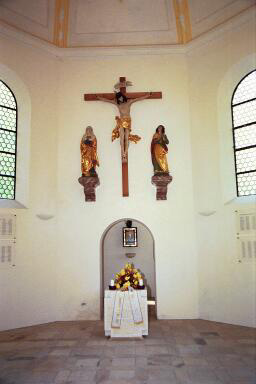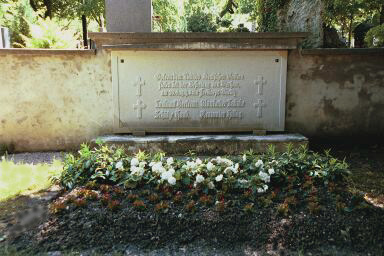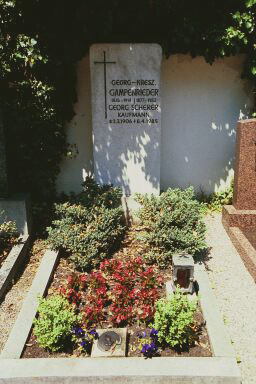Altfriedhof Dachau's oldest existing burial plot is the Altfriedhof, which means Old Cemetery in German. It is located on Gottesackerstrasse, which is just off Augsbergerstrasse, one of the two main streets in the town. Gottersacker means "God's own acre." This cemetery was started in 1571 after the original cemetery in the churchyard of St. Jakob's Church was filled up. A beautiful Baroque chapel, called the Chapel of the Holy Cross, was built here between 1627-1628. This Chapel was dedicated in 1961 to Dachau's war dead. The photograph above shows the Chapel with graves in front of it. In the photograph below, you can see the interior of the Chapel. Notice the names on the walls on both sides under the windows. These are the names of German soldiers from Dachau who were killed in the two World Wars.  If you've never seen a German graveyard, you are in for a real treat. Each grave looks like a miniature garden with flowers and low shrubs planted over the burial site. Relatives of the deceased lovingly tend to these graves, watering and weeding regularly, not just on Memorial Day. Fresh flowers decorate many of the graves, mingling with the plants and other decorations. German cemeteries are beautifully maintained. You will not find a "faded leaf or blighted blossom" anywhere among the graves. It is common in German cemeteries to bury the dead on top of older graves, so you won't see any graves from the 16th century. There are, however, graves with dates going back to the 1800ies. Some of Dachau's famous artists are buried here, including Hermann Stockmann. History buffs will be interested in the grave shown in the photograph below. This is the final resting place of four men of the Freikorps Görlitz, a militia group which fought the Red Army of the Communists. The names on the grave stone shown below are 2nd Lieutenant Bertram, Muskateer Labuke, Private Hauk, and Gunner Hilbig. They were killed near the village of Pellheim, just outside the town of Dachau, on April 30, 1919. They were engaged in a battle against the Communists who had set up a Soviet government in the state of Bavaria, after overthrowing the imperial government, under their Jewish leader Kurt Eisner, on November 7, 1918.  This memorial stone for the men who died while liberating Dachau from the Communists was set in place on April 29, 1934. Ironically, on this same date eleven years later, the American Seventh Army liberated their Communist allies from the Nazi concentration camp in Dachau. Many of the men who later became top Nazi leaders fought with other divisions of the Freikorp, including Heinrich Himmler, the man who set up the first concentration camp at Dachau. The first 200 prisoners brought to the Dachau camp on March 22, 1933 were Communists who had been taken into "protective custody" because they were considered to be "enemies of the state." In the early days of the Dachau concentration camp, the bodies were not burned, as there was as yet no threat of epidemics, and cremation was not customary back then. The first prisoners who died in the concentration camp were brought to the Old Cemetery to be buried. One of the first to be buried here was a Communist member of the Reichstag, 32-year-old Franz Stenzer, who was "shot while attempting to escape" from the concentration camp on August 22, 1933. In those days, a death in the camp was a big event and the SS men even attended the funerals. The photograph below shows the grave of Georg Scherer, a Dachau resident who was a prisoner in the Nazi concentration camp for five years. After the war, Scherer was elected Mayor of Dachau. Scherer was sent to the Dachau camp on December 22, 1935 because of his anti-Nazi resistance activity, but was released on January 17, 1941. As a prisoner, Georg was living at the same place where he had served an apprenticeship as a lathe operator in 1921 at the German Industrial Works which was located on the site of the former gunpowder factory. After he was released from the Dachau camp, Scherer continued to work in a factory in the SS camp, right next to the concentration camp. The day before American Soldiers arrived in Dachau, Georg led the Dachau Uprising in which residents of the town joined escaped prisoners in fighting against the SS soldiers. Another prisoner, Walter Neff, also remained at the camp after his release, working as an assistant to Dr. Rascher in his medical experiments. Neff also participated in helping the Dachau prisoners to escape and in planning the uprising.  Teufelhart BakeryBack to List of Historic PlacesBack to Table of ContentsHome |